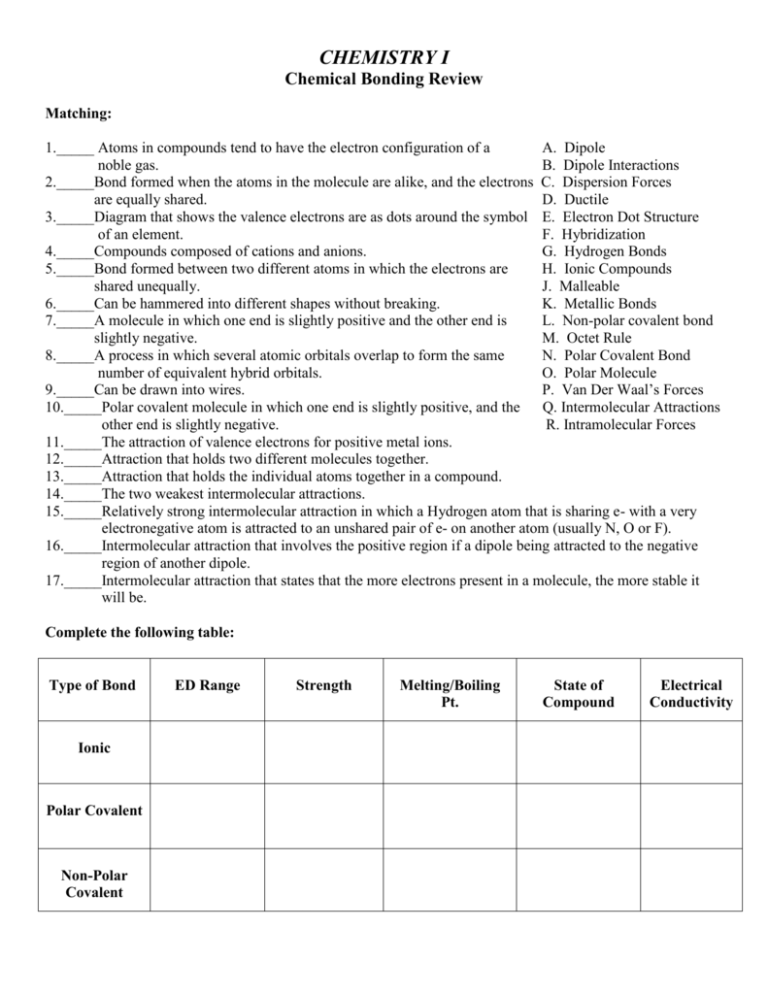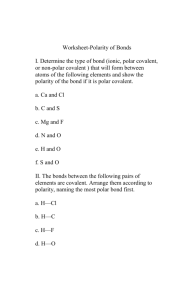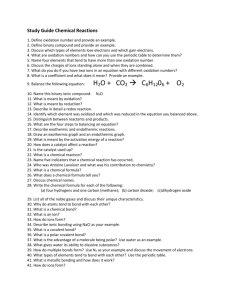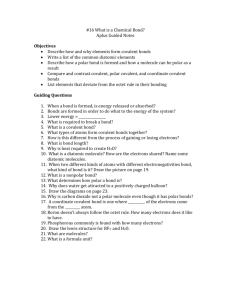CHEMISTRY I
advertisement

CHEMISTRY I Chemical Bonding Review Matching: 1._____ Atoms in compounds tend to have the electron configuration of a A. Dipole noble gas. B. Dipole Interactions 2._____Bond formed when the atoms in the molecule are alike, and the electrons C. Dispersion Forces are equally shared. D. Ductile 3._____Diagram that shows the valence electrons are as dots around the symbol E. Electron Dot Structure of an element. F. Hybridization 4._____Compounds composed of cations and anions. G. Hydrogen Bonds 5._____Bond formed between two different atoms in which the electrons are H. Ionic Compounds shared unequally. J. Malleable 6._____Can be hammered into different shapes without breaking. K. Metallic Bonds 7._____A molecule in which one end is slightly positive and the other end is L. Non-polar covalent bond slightly negative. M. Octet Rule 8._____A process in which several atomic orbitals overlap to form the same N. Polar Covalent Bond number of equivalent hybrid orbitals. O. Polar Molecule 9._____Can be drawn into wires. P. Van Der Waal’s Forces 10._____Polar covalent molecule in which one end is slightly positive, and the Q. Intermolecular Attractions other end is slightly negative. R. Intramolecular Forces 11._____The attraction of valence electrons for positive metal ions. 12._____Attraction that holds two different molecules together. 13._____Attraction that holds the individual atoms together in a compound. 14._____The two weakest intermolecular attractions. 15._____Relatively strong intermolecular attraction in which a Hydrogen atom that is sharing e- with a very electronegative atom is attracted to an unshared pair of e- on another atom (usually N, O or F). 16._____Intermolecular attraction that involves the positive region if a dipole being attracted to the negative region of another dipole. 17._____Intermolecular attraction that states that the more electrons present in a molecule, the more stable it will be. Complete the following table: Type of Bond Ionic Polar Covalent Non-Polar Covalent ED Range Strength Melting/Boiling Pt. State of Compound Electrical Conductivity Given the following compounds: Na3P H2 CCl4 KBr silver coins (Ag and Cu) 18. Label each type of bond present in the compounds above. 19. Which has the lowest boiling point? 20. Which is ductile? 21. Which is (are) most likely to be gases? 22. Which will dissolve in water? 23. Which is malleable? 24. Which will NOT conduct electricity? 25. Rank the compounds from most polar bond to least polar bond. 26. Draw the Lewis Dot Structure for each compound to determine whether its shape is polar or non-polar. What is oxidation number of the following electron configurations? 27. 1s2 2s2 2p6 3s1 28. 1s2 2s2 2p6 3s2 3p6 4s2 3d10 29. 1s2 2s2 2p6 3s2 3p5 30. 1s2 2s2 2p6 3s2 3p1 Short Answer: Four types of intramolecular bonds: ______________, ______________, ______________, & ____________ Three types of intermolecular attractions: _______________, _______________, _______________ Rank these seven attractions in order from strongest to weakest: Classify the following statements as always true (AT), sometimes true (ST) or never true (NT): 31. _____ The chlorine atom gains seven electrons when it becomes an ion. 32. _____ Atoms acquire the stable electron structure of a noble gas by losing electrons. 33. _____ Sulfur and magnesium both have two valence electrons. 34. _____ Ionic compounds can conduct electricity in their molten state. 35. _____ Metals are good conductors of electricity because electrons can flow freely through them. 36. _____ In a polar covalent bond, the more electronegative atom has a slight positive charge. 37. _____A molecule with polar bonds is dipolar. 38. _____Two atoms with an electronegativity difference greater than 2.0 will form an ionic bond. 39. _____ van der Waals forces are weaker than hydrogen bonds. 40. _____ In general, the electronegativity values are large for metals elements and small for non-metals. 41. _____ Unshared pairs of electrons affect the shape of molecules. 42. _____ Van der Waals forces are an example of an intramolecular force. 43. _____ Carbon forms four single covalent bonds with other atoms. 44. _____ In general, non-polar covalent compounds are hard, crystalline compounds with high melting points. 45. _____ NH4+ is an example of a polyatomic atom. 46. _____ Covalent bonds are the strongest type of intramolecular bond.







